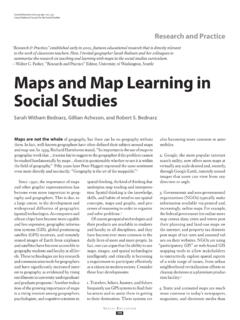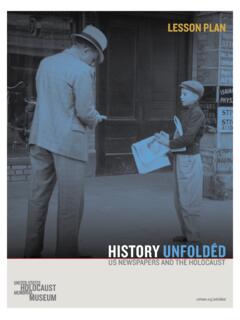Transcription of Teaching and Learning African American History ©2017 ...
1 Social Education 81(1), pp 14 18. 2017 National Council for the Social Studies Teaching and Learning African American History The Status of Black History in Schools and Society LaGarrett J. King The year 2015 marked a century since Carter G. Woodson and his colleagues cre- tion highlighting the purpose and limita- ated the Association for the Study of Negro Life and History (originally ASNLH, tions of a Black History curriculum. In now ASALH), the first Black History organization that successfully promoted, the issue, Nathan Hare and Louis Harlan researched, preserved, interpreted, and disseminated information about Black life, exemplified the various arguments about History , and culture to the global community. 1 Woodson, with help from ASALH, the significance of Black History . Hare, had a profound impact on efforts to institutionalize Black History in schools. Between for example, explained that a Black his- 1915 and 1950, Woodson and his colleagues established a foundation for K-12 Black tory curriculum and instruction should History education.
2 They did so by authoring several K-12 Black History textbooks, focus on social justice, militancy, and self- designing Black History home study courses for school-aged children, establishing a improvement, while Harlan believed K-12 Black History teacher journal, and promoting Negro History Week (now Black that Black History instruction should be History Month) in Woodson envisioned these programs as temporary, and more subtle, apolitical, and integrated only the first steps at integrating K-12 Black History within the mainstream social within traditional History studies curriculum. In school districts across the , Black students, teachers, and parents The mainstream social studies cur- began to demand that Black History riculum, however, either largely ignored courses become either part of the social Black History or misrepresented the studies curriculum or exist as stand- subject. Early renditions of History text- alone courses. Some schools/school dis- books typically classified Black people tricts especially those with large Black as docile, uncivilized, and lazy.
3 For populations established Black History example, a 1934 History textbook analy- courses, and it was this type of experi- sis by Lawrence Reddick observed that ence which became the foundation of Black people were portrayed as being the multicultural education content as slaves; they liked to sing, dance, crack jokes, and laugh; admired A Contemporary Look at Black bright colors, never in a hurry, and [were] History always ready to let things go until the Today, the legitimacy of K-12 Black his- morrow. 3 These examples illustrated tory as an academic subject for school- a social studies curriculum mirroring a children is largely unquestioned. Take culture that elevated those consid- for instance the report, Research into ered to be White while simultaneously the State of African American History demeaning all of those considered to be with the 1961 California law, seven states and Culture in K-12 Public Schools, Black. It was not until the middle of the passed laws requiring or recommending conducted by the National Museum twentieth century that mainstream social that the contributions and achievements of African American History and studies textbooks began to eliminate text of minority groups be included in school Culture (NMAAHC).
4 With the help that was explicitly curricula. 5 The study also chronicled of an evaluator, Oberg Research, this Inspired by the 1960s civil rights the development of several school dis- 2015 study sought to understand how movement, systemic efforts to main- tricts' Black studies programs, complete social studies teachers conceptualized stream K-12 Black History began to build with their own textbooks and resources. and implemented a K-12 Black History momentum. A 1969 survey conducted by Additionally, Social Education, with its curriculum. The methodology included Education USA indicated that, starting April 1969 issue, published a special edi- a nationwide survey of 525 elementary, S o c i a l E d u c at i o n 14. middle, and high school teachers, 72 NMAAHC's study also notes that Smithsonian in-depth personal interviews,8 and 5. focus groups,9 and a review of social teachers may not teach Black History as much as they should because they American Art studies standards from all 50 states lack content knowledge, confidence, Museum and the District of Columbia.
5 Key time, and resources, and are con- findings indicate that teachers con- cerned with students' maturity levels sidered Black History as influential in for approaching difficult knowledge. understanding the complexity of The general consensus, however, is History , with many teachers stating that that Black History should be included they infuse elements of Black History in the curriculum, but (as the previ- in every historical era, sometimes ously mentioned debate between going beyond state and local stan- Hare and Harlan showed), there is dards. Teachers noted that topics such concern about how and what content as forced African migration, Brown v. should be delivered. Board of Education, the impact of the There is no doubt that Black History Civil Rights Acts of 1960s, and the has become engrained in the nation's Obama election were the most taught lexicon, probably making it one of the subjects by teachers. Teachers also most popular subsets of History enacted pedagogies such as inviting taught in K-12 Several guest speakers from academia and the factors contribute to Black History 's community, primary sources, movie popularity.
6 First, Black History clips, virtual fieldtrips, and web quest Month in schools is now celebrated What can we find activities. Yet, despite teachers' enthu- in many different countries. Teachers in this picture? siasm about Teaching Black History , the sometimes see Black History Month study surmised that generally only 1 to as a liberating time to offer different a. A family portrait 2 lessons or 8 9 percent of total class pedagogical approaches and disrupt b. A reference to Hamlet time is devoted to Black History in an inequitable and limited curricu- History classrooms. Second, Black History museums c. A new nation's hopes The study represents a conundrum have become increasingly salient in for independence for Black History in the classroom. For providing educational opportunities d. All of the above one, K-12 Black History can be seen for Black History Learning . The newly as successful to the extent that stu- created National Museum of African dents are now aware of famous Black American History and Culture is an leaders: Wineburg and Monte-Sano's indication of the national impor- Explore American art's Famous American study saw 2,000 tance of examining Black History .
7 Connections to your curricula high school students name Martin Even before NMAAHC, many state Luther King Jr, Rose Parks, and and local Black History museums and make History present. Harriet Tubman as the most famous contributed to K-12 Black History historical figures in the United States enrichment for students and teach- other than presidents and their ers through activities such as Black Summer Institutes: Yet the Southern Poverty Law Center's History summer camps, lecture series, Teaching the Humanities report, Teaching the Movement 2014: historical reenactments, and storytell- through Art The State of Civil Rights Education ing. A few other museums such as the in the United States, noted that the Reginald Lewis Museum in Baltimore, majority of states received grades Maryland, and DuSable Museum July 10 14, 2017. of Ds and Fs for their approach to in Chicago, Illinois, have even col- July 24 28, 2017. Teaching the civil rights movement, laborated with their respective state with five states neglecting the sub- departments of education to create ject all Additionally, other elementary and secondary K-12 Black /education/dev/institutes research has indicated that teachers History curriculum.
8 Black History pro- ignore Black History and that what is fessional development opportunities taught is sometimes lethargic, too cel- for teachers are also common at Black Charles Willson Peale, Mrs. James Smith and Grandson (detail), 1776. Smithsonian American Art Museum, Gift of Mr. and Mrs. Wilson ebratory, and lacks complexity. The History museums as well as throughout Levering Smith Jr. and museum purchase. J a n u a r y / F e b r u a r y 2 0 17. 15. various community-based organizations division: Holt McDougal], and cant contributions to the development and education and History departments In addition, school districts in Chicago, of this country. 21 Curricular mandates on university campuses. Minneapolis, and Philadelphia have in Florida, south carolina , and Rhode Third, popular culture and visual required that Black History classes Island suggest that Black History begins media outlets have been influential in be taught at all grade The with Africa.
9 Florida defines Black his- providing another space for Black his- Philadelphia city school district has tory as the History of African Americans, torical study. Recent movies such as The made a yearlong African American his- including the History of African peoples Help, 12 Years a Slave, Selma, and The tory course a requirement for high school before the political conflicts that led to Birth of a Nation have all been devel- Recently, Teachers College the development of slavery, the passage oped into K-12 curriculum and have been at Columbia University, the African of America, the enslavement experi- made available across the The Diaspora Consortium, and the College ence, abolition, and the contribution of Chicago-based television station, WGN Board have collaborated to develop the African Americans to society. 22. America in a partnership with Sony pic- first Black History advanced placement Many of the Black History mandates tures, has developed a successful TV course.
10 The course will focus on the are subject to criticism. Citizens in series about the Underground Railroad. African Diaspora and will be piloted Illinois and New York have complained Harvard University's Henry Louis Gates' in several school districts during the that the mandates are in name only and Black History series: Finding Your Roots, 2017 2018 school year. have no real and tangible purpose; this Black in Latin America, Many Rivers to critique is based on the lack of cur- Cross, and Black America since MLK, Black History Mandates riculum enactment, enforcement, and have enjoyed tremendous success on The establishment of Black History man- financial assistance. Others just rehash Public Broadcasting Service stations. dates in a number of states is another the same old narratives of enslavement Even streaming networks such as Netflix sign of the popularity of Black History . and the civil rights movement. While have produced some Black History con- States such as Arkansas, Florida, Illinois, these topics need attention, Black his- tent, as evident in the popular documen- New Jersey, New York, Mississippi, and tory can become stagnant when the same tary 13th.









